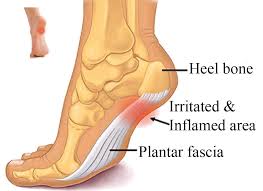The plantar fascia is a thick band of connective tissue on the sole of the foot which spans from the heel to the toes. It helps to create foot stability through the arch, and acts as a “spring” to store and generate power assisting our economy to walk and run.
What is plantar fasciitis?
Plantar fasciitis is the term used to describe pain, microtrauma and (if present) inflammation that presents in the plantar fascia as it inserts into the heel bone. While it is also possible to tear the fascia, this condition is usually an overuse injury that develops from repetitive stress on the fascia from repetitive stretching and micro-stress of the “spring-like” connective tissue. It is particularly common in:
– Runners (especially those with excessively flat feet, those with high arch, stiff feet or those with reduced range of movement in the toe joints and/or weak small muscles of the foot)
– Overweight populations
– Pregnant women
– Those who wear inadequate footwear
– Those with foot biomechanical foot issues
 Symptoms
Symptoms
Pain tends to develop gradually under the bottom of the heel and can affect one or both feet- the pain often starts by feeling like a stone bruise.
Morning pain is a common, particularly with the first few steps taken after getting out of bed.
Pain may also be present with prolonged standing, walking, and power activities such as running and when hopping on the affected leg.
In a true Plantar Fasciitis pathology, pain will be felt when palpating the insertion of the plantar fascia under the heel bone. If a fascia tear is present, the pain may extend towards the toes somewhat, however, it is important to differentiate the region of palpation pain to help differentiate this condition from other less common foot problems.
Diagnosis
Diagnosis is made based on a number of signs, symptoms, and clinical tests including:
– Observation of foot, knee, and hip mechanics with standing/walking/running
– Muscle strength and tone (or muscle tension): especially assessing the small muscles within the foot that contribute to good foot posture
– Specific palpation within the foot
– Mobility testing of the ankle and foot joints
Collectively, these help to confirm the plantar fascia as the cause of the symptoms.
Imaging investigations may be needed, particularly to determine if a tear is present, or to differentiate if a plantar bone spur is present also under the base of the heel. Scans may commonly include X-rays and MR. Images need to be read with caution however, as positive finding may not actually be symptomatic and the cause of the pain and limited function.
Treatment
If untreated and ignored, plantar fasciitis may result in long-term pain that can hinder normal activity. Due to the way in which this pathology can change your walking/running style, it can also lead to the development of other issues in the feet, knees, hips, and lower back.
Treatment often includes
– Muscular and myofascial releases through the sole of the foot, calf, and hamstring.
– Dry needling of the foot and calf to release excess muscle and soft tissue tension in these regions
– Stretching of the calf complex (the fascia sheath around the calf becomes continuous with the plantar fascia so any additional calf tension may increase tension in the plantar fascia)
– Advice on supportive footwear and training modifications
– Correcting foot function: this may involve mobilising stiff feet and strengthening the small foot muscles in weak feet and overpronator.
– Strength and Control training of the calf muscles and foot intrinsic muscles
– Taping for foot arch support and unloading of the plantar fascia: if taping relieves symptoms, a visit to the Podiatrist may be indicated as you may benefit from custom orthotics
– Night splinting to facilitate prolonged stretching of the muscles and fascia in the foot/calf.
– A corticosteroid injection may be trialed if conservative management is not successful
What can GCPSH do for your Plantar Fasciitis?
Plantar foot pain is not uncommon and Plantar Fasciitis is only one cause of pain under the bottom of your foot. Many other intrinsic foot conditions are often diagnosed as this, but are actually a different or more complicated foot pathology The physiotherapists at GCPSH are experts in biomechanical analysis and assessing function, including running technique.
After completing a thorough assessment to identify the potential causes of yourplantar fasciitis, they will then assess your running technique to determine any technique-related causes. This will then allow them to specifically address your running technique with drills and exercises, as well as hands on treatment tailored to you. We will be able to advise if a visit to the Podiatrist will be beneficial and assist in advice on whether your shoes need replacing, or you need a different shoe type.
All physiotherapists at GCPSH are trained and qualified in a form of acupuncture called dry needling which may also aid with your recovery.
GCPSH hold a running technique coaching class on the first Saturday of each month to help improve your running mechanics and technique, click here for more information regarding the class


































